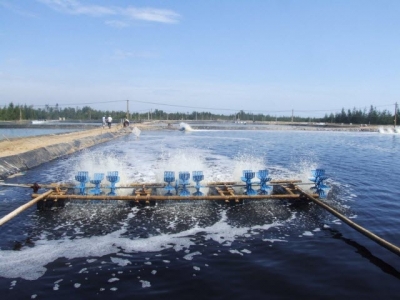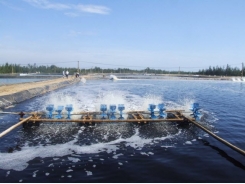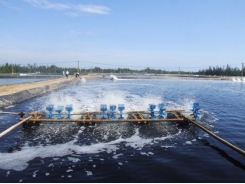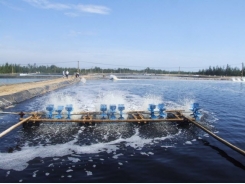The importance of biosecurity and disinfection in aquaculture (Part 3)

Health Diagnosis
Some early warning signs of disease in a population of shrimp, prawn or fish include changes in behavior or appearance, reduced or absent feeding response, as well as increases in morbidity (sick once) and moribund (mortality). In many cases, two or more factors, such as changes in water quality, handling, parasites or bacteria, will have contributed to the disease outbreak and each must be corrected.
Records of water quality and management actions should be reviewed for early warning and any problems should be corrected. Nutritional programs should be examined for completeness (this will vary depending upon the species requirements and life stage) and storage of feeds should be evaluated to ensure feeds are stored properly (cool temperatures, low humidity and for minimal periods).
Shrimp, prawn and fish should be evaluated, preferably with the assistance of a health specialist. Early warnings will include behavioral changes, lack of feeding and any obvious external signs of disease (e.g., white spots, hemorrhages, vibriosis, or presence of protozoa or fungi). A representative sample of sick shrimp, prawn and fish should be sacrificed for necropsies. Necropsies should include examination of all tissues for appearance and presence of abnormalities; search for external and internal parasites; microbiological culture of pertinent organs; histopathology; and virology, if warranted. Any necessary treatments should then be based on findings from all pertinent tests.
Knowledge of how treatments affect the system is also important. Their proper use in aquaculture systems should be understood and all relevant issues should be determined prior to their use. Work with knowledgeable aquaculture specialists prior to starting aquaculture venture. Such efforts will maximize the chances of success.
Designs and components of biosecurity systems continue to be upgraded and streamlined, but basic management principles remain unchanged. Preventative medicine is critical. Preventative medicine includes proper attention to species biology, genetics, water quality, nutrition, system design, quarantine, sanitation, disinfection and overall management. An understanding of common diseases is also important. Common infectious and non-infectious diseases will vary from one species to another.
It is of primary importance to understand the serious implications of not implementing biosecurity strategies, quantitative assessment of risks, constant surveillance and detailed record keeping. This is particularly important in our aquaculture operation systems where predators, scavengers and poachers can pose serious threats in the transportation of pathogenic viruses, bacteria, protozoa, fungi etc. from one site to another.
Biosecurity is the management practices that prevent non-infected, healthy animal populations from being exposed to infectious or parasitic agents. Common biosecurity measures include:
1/ Sanitation
Sanitation includes the cleaning and disinfecting of hatcheries, holding facilities, tanks, ponds, handling and vaccination equipment, etc. Cleaning must be done before disinfecting. Disinfectants include chlorine, heat, steam, formalin, and other chemical compounds. All of the chemical disinfectants are toxic, so all equipment should be rinsed well after disinfecting.
2/ Vertical disease transmission
Vertically transmitted diseases (from parent to offspring) can be prevented by using healthy, disease-free broodstock.
3/ Egg disinfection
Egg disinfection with iodine or other solutions at the time of the water hardening of eggs can reduce the incidence of disease problems of eggs and larvae.
4/ Traffic
Restricting people and equipment traffic can reduce the chance of disease transmission from one facility to another.
5/ Water treatments
Water treatments of incoming or recirculating water decreases the chance of pathogenic organisms entering the culture system. Treatments include mechanical filtration, UV light, and ozone.
6/ Effluent treatment
Treatment of wastewater from aquaculture facilities and processing plants reduces the release of microorganisms into the environment. This is important, because there have been problems in the past with diseases re-entering an aquaculture facility from wastewater of a processing plant. Infected water from the plant was released, and then this water was taken into the aquaculture system.
7/ Clean feed
It is important to use clean, fresh feed. Proper handling and storage of feed can reduce food-borne disease organisms.
8/ Disposal of mortalities
The proper disposal of mortalities by incineration, burial, or composting will reduce the risk of recycling diseases. It is also important to remove dead fish from the tank or raceway often to reduce the likelihood of spreading the infection.
One of the challenges faced by aquaculturists is to offer all the life stages of their animal’s proper sanitary conditions and Biosecurity. A comprehensive biosecurity program should be in place. This is essential in combating and preventing disease.
With the rapid increase in intensive aquaculture, the need for disinfectants has also increased. Entry and growth of pathogens must be minimized through use of disinfectants in water, on tanks and equipment, and on eggs. Disinfectants used in aquaculture are aimed at all types of infectious agents (including bacteria, fungi, viruses and protozoa). Disinfectants kill disease- causing organisms by releasing proper amounts of chlorine or iodine or other compounds.
A Proliferation of Pathogens
Pathogen. The word conjures up horrific thoughts of plague and death. It comes from the Greek word for ‘feeling’ or ‘disease’. It comes from kids with snotty noses that you pick up from daycare. They got it from some other kid whose parents aren’t as diligent about hygiene. Simplistic maybe, but the principle is the same whether it is people or fish: pathogens are transferable and they get that way by making copies of themselves.
Pathogens are organisms that cause disease. They can be viral, bacterial, fungal or parasitic. On the size scale, viruses can be nanometers wide (millionths of a millimeter) and only visible with an electron microscope, while bacteria are microns wide (thousandths of a millimeter) and visible with light microscopes at high power. Fungi and parasites are both macroscopic and microscopic.

The common aspect among all of these pathogens is that when present in large enough numbers, they produce toxins, disrupt cell function, or overuse resources of the host while feeding their own needs to reproduce. Not a pleasant thought.
Related news
Tools

Phối trộn thức ăn chăn nuôi

Pha dung dịch thủy canh

Định mức cho tôm ăn

Phối trộn phân bón NPK

Xác định tỷ lệ tôm sống

Chuyển đổi đơn vị phân bón

Xác định công suất sục khí

Chuyển đổi đơn vị tôm

Tính diện tích nhà kính

Tính thể tích ao




 The importance of biosecurity and disinfection in aquaculture…
The importance of biosecurity and disinfection in aquaculture…  The importance of biosecurity and disinfection in aquaculture…
The importance of biosecurity and disinfection in aquaculture…